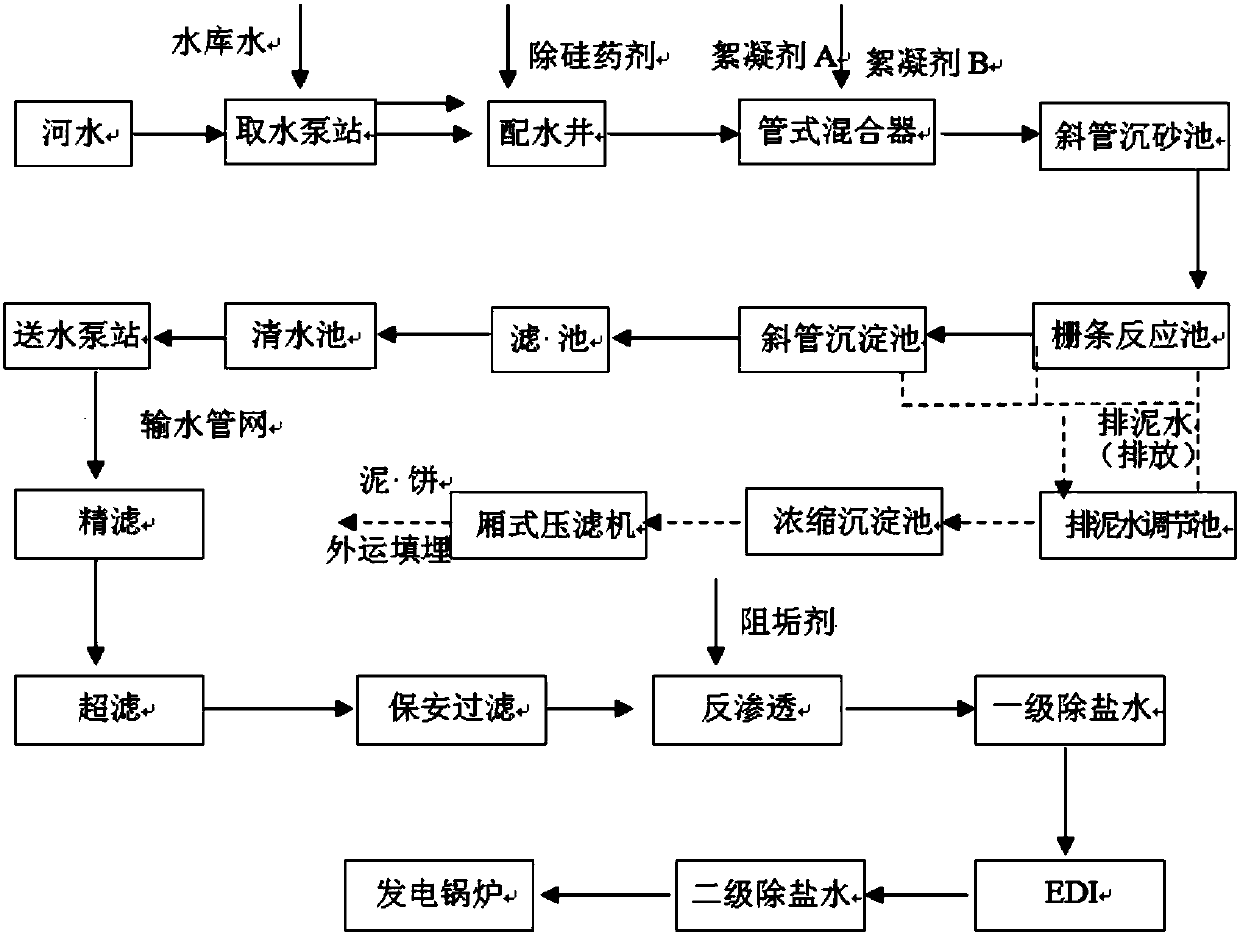Method and treatment system for reducing silicon content in industrial water
A technology for industrial water and silicon content, applied in water/sewage treatment, water/sewage multi-stage treatment, water/sludge/sewage treatment, etc., can solve the problem of increasing the silicon removal load of the primary desalination station and the small processing capacity , environmental pollution and other issues, to achieve the effect of improving the conductivity of water quality, stable pH value of water quality, and wide source of raw materials for treatment
- Summary
- Abstract
- Description
- Claims
- Application Information
AI Technical Summary
Problems solved by technology
Method used
Image
Examples
Embodiment 1-3
[0083] A method for reducing silicon content in industrial water, which is treated by compound addition of several chemicals, including:
[0084] Produce a certain period of time, add 7wt% soda ash, sodium hydroxide and unslaked lime (that is, what embodiment 1 adds is soda ash, what embodiment 2 adds is sodium hydroxide, what embodiment 2 adds is sodium hydroxide in the raw water of high silicon water quality to be treated earlier. 3 What is added is quicklime), and then add 0.25wt% polyaluminum chloride after mixing evenly, after mixing evenly for 20 minutes, then add 1.5wt% cationic polyacrylamide, and then carry out precipitation and filtration treatment to reduce water silicon content.
[0085] The soluble silicon content in the raw water with high silicon water quality in Examples 1-3 is 7117 μg / L, the soluble silicon content in the treated water is 1188 μg / L, 1175 μg / L and 1182 μg / L respectively, and the silicon removal rate is 83.3 %, 83.5% and 83.4%.
Embodiment 4-6
[0087] A method for reducing silicon content in industrial water, which is treated by compound addition of several chemicals, including:
[0088] Produce a certain period of time, add 3wt% milk of lime earlier in the raw water of high silicon water quality to be treated, stir and mix and then add 0.15wt% polyaluminum sulfate, polyferric chloride and polyferric sulfate (i.e. embodiment 4 What added was polyaluminum sulfate, what embodiment 5 added was polyferric chloride, what embodiment 6 added was polyferric sulfate), after mixing uniformly for 40min, add 1.0wt% cationic polyacrylamide again, then Precipitation and filtration are carried out to reduce the silicon content in the water.
[0089] The soluble silicon content in the raw water with high silicon water quality in Examples 1-3 is 5216 μg / L, the soluble silicon content in the treated water is 965 μg / L, 948 μg / L and 955 μg / L respectively, and the silicon removal rate is 81.5 %, 81.8% and 81.7%.
Embodiment 7-9
[0091] A method for reducing silicon content in industrial water, which is treated by compound addition of several chemicals, including:
[0092] For a certain period of production, add 8wt% sodium hydroxide to the raw water with high silicon quality to be treated, stir and mix well, then add 0.35wt% polyaluminum chloride, mix evenly for 60 minutes, then add 2.0wt% Cationic polyacrylamide, anionic polyacrylamide and nonionic polyacrylamide (that is, what was added in embodiment 7 was cationic polyacrylamide, what was added in embodiment 8 was anionic polyacrylamide, and what was added in embodiment 9 was anionic polyacrylamide. Dosing is non-cationic polyacrylamide), followed by precipitation and filtration treatment to reduce the silicon content in water.
[0093] The soluble silicon content in the raw water with high silicon water quality in Examples 1-3 is 10087 μg / L, the soluble silicon content in the treated water is 1817 μg / L, 1810 μg / L and 1795 μg / L respectively, and th...
PUM
 Login to View More
Login to View More Abstract
Description
Claims
Application Information
 Login to View More
Login to View More - R&D
- Intellectual Property
- Life Sciences
- Materials
- Tech Scout
- Unparalleled Data Quality
- Higher Quality Content
- 60% Fewer Hallucinations
Browse by: Latest US Patents, China's latest patents, Technical Efficacy Thesaurus, Application Domain, Technology Topic, Popular Technical Reports.
© 2025 PatSnap. All rights reserved.Legal|Privacy policy|Modern Slavery Act Transparency Statement|Sitemap|About US| Contact US: help@patsnap.com


